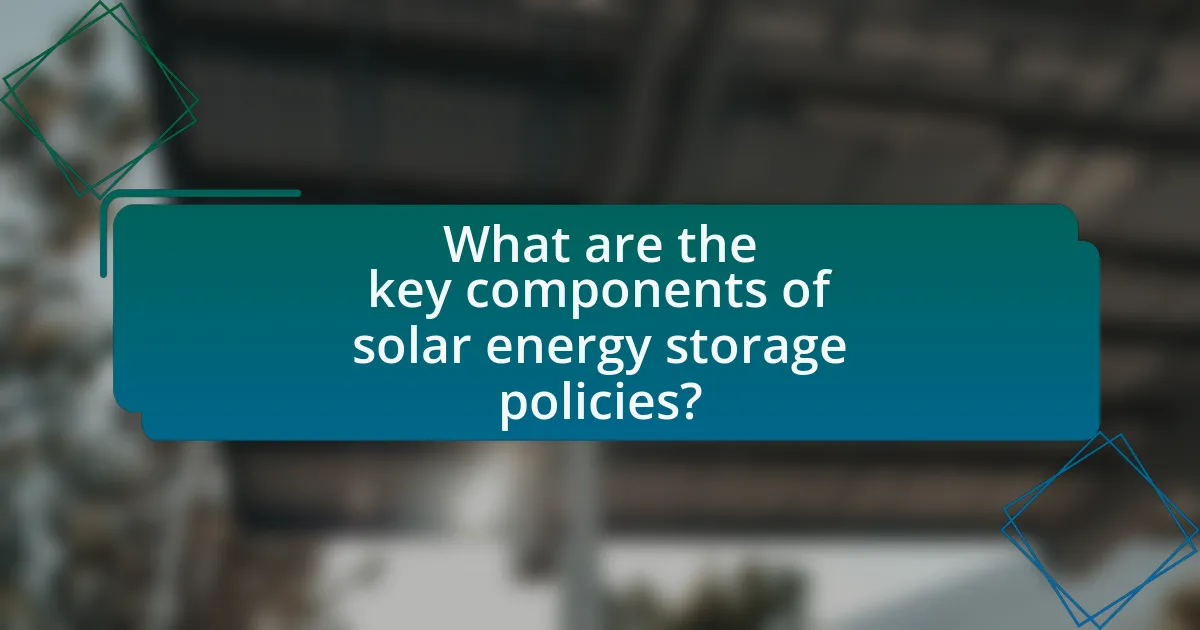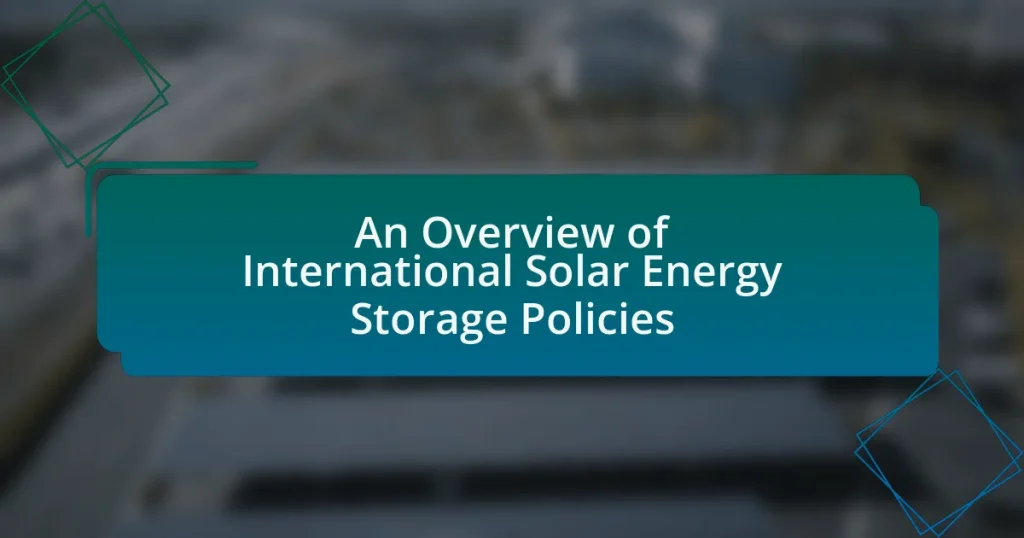International Solar Energy Storage Policies are regulatory frameworks designed to enhance the integration of energy storage systems within solar energy projects, addressing challenges such as intermittency and grid stability. The article examines how these policies vary across countries, influenced by factors like government priorities, economic conditions, and technological advancements. It highlights the importance of financial and non-financial incentives, regulatory frameworks, and the role of cultural and economic contexts in shaping these policies. Additionally, the article discusses the challenges faced in implementing effective solar energy storage policies and outlines best practices for enhancing their effectiveness and public support.
What are International Solar Energy Storage Policies?


International Solar Energy Storage Policies are regulatory frameworks and guidelines established by various countries to promote the development and integration of energy storage systems in solar energy projects. These policies aim to enhance the efficiency, reliability, and sustainability of solar energy by addressing challenges such as intermittency and grid stability. For instance, countries like Germany and the United States have implemented incentives such as tax credits, grants, and feed-in tariffs to encourage investment in solar energy storage technologies. Additionally, the International Energy Agency (IEA) reports that effective energy storage policies can significantly increase the share of renewables in the energy mix, thereby contributing to global climate goals.
How do these policies vary across different countries?
Solar energy storage policies vary significantly across countries due to differences in government priorities, economic conditions, and technological advancements. For instance, Germany has implemented comprehensive incentives for solar energy storage, including feed-in tariffs and subsidies, which have led to a high adoption rate of residential battery systems. In contrast, the United States has a more fragmented approach, with policies varying by state; California offers strong incentives for solar storage, while other states may lack such support. Additionally, countries like China focus on large-scale energy storage projects, driven by state-owned enterprises and significant investment in technology development. These variations reflect each country’s unique energy needs, regulatory environments, and market dynamics.
What factors influence the differences in solar energy storage policies globally?
Differences in solar energy storage policies globally are influenced by factors such as government regulations, economic incentives, technological advancements, and regional energy needs. Government regulations shape the framework within which solar energy storage operates, with some countries implementing supportive policies while others impose restrictions. Economic incentives, including subsidies and tax credits, encourage investment in solar storage technologies, varying significantly across nations. Technological advancements impact the efficiency and cost-effectiveness of storage solutions, leading to differing adoption rates. Additionally, regional energy needs, such as reliance on fossil fuels or renewable energy targets, dictate the urgency and focus of solar energy storage policies in different countries.
How do cultural and economic contexts shape these policies?
Cultural and economic contexts significantly shape international solar energy storage policies by influencing public perception, investment priorities, and regulatory frameworks. For instance, countries with a strong cultural emphasis on sustainability, such as Germany, tend to implement more aggressive policies promoting solar energy storage, supported by public acceptance and demand for renewable energy solutions. Economically, nations with higher GDPs can allocate more resources towards research and development in solar technologies, leading to more advanced and comprehensive policies. In contrast, developing countries may prioritize immediate economic growth over long-term sustainability, resulting in less robust solar energy storage initiatives. This relationship is evident in the varying levels of solar energy adoption and storage solutions across different regions, reflecting both cultural values and economic capabilities.
Why are solar energy storage policies important?
Solar energy storage policies are important because they facilitate the integration of renewable energy into the grid, ensuring reliability and stability. These policies encourage investment in energy storage technologies, which are essential for managing the intermittent nature of solar power. For instance, according to the International Energy Agency, energy storage capacity is projected to grow significantly, reaching 1,200 gigawatts by 2040, driven by supportive policies. This growth enhances energy security, reduces reliance on fossil fuels, and contributes to climate change mitigation efforts.
What role do these policies play in promoting renewable energy adoption?
Policies play a crucial role in promoting renewable energy adoption by providing financial incentives, regulatory frameworks, and support mechanisms that encourage investment and development in renewable technologies. For instance, feed-in tariffs and tax credits lower the cost barrier for solar energy projects, making them more attractive to investors. According to the International Renewable Energy Agency, countries with supportive policies have seen a significant increase in renewable energy capacity; for example, Germany’s feed-in tariff policy led to a tenfold increase in solar capacity from 2000 to 2010. These policies create a stable environment that fosters innovation and growth in the renewable energy sector, ultimately accelerating the transition to sustainable energy sources.
How do they impact energy security and sustainability?
International solar energy storage policies enhance energy security and sustainability by facilitating the integration of renewable energy sources into the grid. These policies promote the development of energy storage technologies, which mitigate the intermittency of solar power, ensuring a reliable energy supply. For instance, countries like Germany and Australia have implemented incentives for solar battery storage systems, leading to increased energy independence and reduced reliance on fossil fuels. This transition not only lowers greenhouse gas emissions but also stabilizes energy prices, contributing to long-term sustainability.
What are the key components of solar energy storage policies?


The key components of solar energy storage policies include regulatory frameworks, financial incentives, technology standards, and integration strategies. Regulatory frameworks establish the legal and operational guidelines for energy storage systems, ensuring compliance and safety. Financial incentives, such as tax credits and grants, encourage investment in solar storage technologies, making them more accessible. Technology standards ensure that storage systems meet performance and safety benchmarks, promoting reliability and efficiency. Integration strategies focus on how solar energy storage can be effectively incorporated into existing energy grids, enhancing overall energy management and sustainability. These components collectively support the growth and effectiveness of solar energy storage initiatives globally.
What types of incentives are commonly included in these policies?
Common incentives included in international solar energy storage policies are financial subsidies, tax credits, and feed-in tariffs. Financial subsidies reduce the upfront costs for solar energy storage systems, making them more accessible to consumers. Tax credits, such as the Investment Tax Credit in the United States, allow individuals and businesses to deduct a percentage of the installation costs from their federal taxes, further incentivizing adoption. Feed-in tariffs guarantee a fixed payment for energy fed back into the grid, providing a stable revenue stream for solar energy producers. These incentives are designed to promote the adoption of solar energy storage technologies and accelerate the transition to renewable energy sources.
How do financial incentives affect the adoption of solar energy storage?
Financial incentives significantly enhance the adoption of solar energy storage by reducing the initial investment costs and improving the return on investment for consumers. For instance, government subsidies, tax credits, and rebates lower the financial barrier, making solar energy storage systems more accessible. According to a report by the International Renewable Energy Agency (IRENA), countries that implemented financial incentives saw a 30% increase in solar storage installations within two years. This correlation indicates that financial incentives not only stimulate market growth but also encourage consumers to transition to renewable energy solutions.
What non-financial incentives are also significant?
Non-financial incentives that are significant in the context of solar energy storage policies include regulatory support, public recognition, and environmental benefits. Regulatory support, such as streamlined permitting processes and favorable zoning laws, encourages the adoption of solar technologies. Public recognition, through awards or certifications, enhances the reputation of organizations and individuals involved in solar energy initiatives. Environmental benefits, such as reduced carbon emissions and improved air quality, provide intrinsic motivation for stakeholders to engage in sustainable practices. These incentives are crucial for fostering a supportive environment for solar energy storage development.
What regulatory frameworks support solar energy storage?
Regulatory frameworks that support solar energy storage include policies such as net metering, feed-in tariffs, and renewable portfolio standards. Net metering allows solar energy system owners to receive credits for excess energy fed back into the grid, incentivizing energy storage solutions. Feed-in tariffs guarantee fixed payments for energy produced from renewable sources, promoting investment in solar storage technologies. Renewable portfolio standards require utilities to obtain a certain percentage of their energy from renewable sources, which can include energy storage systems that enhance the reliability of solar energy. These frameworks collectively encourage the integration of solar energy storage into the energy market, facilitating a transition to cleaner energy sources.
How do regulations differ between developed and developing countries?
Regulations differ significantly between developed and developing countries, primarily in their stringency and enforcement. Developed countries typically have comprehensive regulatory frameworks that emphasize environmental protection, safety standards, and technological innovation, often supported by robust institutions and funding. For instance, the European Union’s Renewable Energy Directive mandates specific targets for renewable energy usage, reflecting a commitment to sustainability. In contrast, developing countries often face challenges such as limited resources, weaker institutional capacities, and less stringent enforcement of regulations. For example, many developing nations may lack the infrastructure to monitor compliance with environmental regulations, leading to inconsistent application of policies. This disparity affects the implementation of solar energy storage policies, where developed countries may promote advanced technologies and incentives, while developing countries may focus on basic regulatory frameworks to encourage investment and access to energy.
What are the challenges in implementing these regulations?
The challenges in implementing solar energy storage regulations include technological limitations, financial constraints, and regulatory inconsistencies. Technological limitations arise from the current state of energy storage technologies, which may not yet be efficient or cost-effective enough for widespread adoption. Financial constraints often stem from the high initial investment required for solar energy systems and storage solutions, which can deter stakeholders from proceeding. Regulatory inconsistencies across different jurisdictions can create confusion and hinder collaboration, as varying standards and requirements complicate compliance efforts. These challenges are supported by studies indicating that technological advancements and financial incentives are crucial for overcoming barriers to solar energy storage implementation.
How are international solar energy storage policies evolving?


International solar energy storage policies are evolving towards increased integration of renewable energy sources, enhanced regulatory frameworks, and financial incentives. Countries are implementing policies that promote energy storage technologies to support grid stability and facilitate the transition to a low-carbon economy. For instance, the European Union has set ambitious targets for energy storage capacity, aiming for 600 GW by 2030, which reflects a significant commitment to renewable energy integration. Additionally, the United States has introduced various state-level initiatives, such as California’s Self-Generation Incentive Program, which provides financial support for energy storage systems. These developments indicate a global trend towards recognizing the critical role of energy storage in achieving energy security and sustainability goals.
What trends are currently shaping these policies?
Current trends shaping international solar energy storage policies include the increasing emphasis on sustainability, technological advancements, and regulatory frameworks promoting renewable energy integration. The global shift towards decarbonization drives governments to implement policies that support solar energy storage as a means to enhance grid reliability and reduce greenhouse gas emissions. For instance, the International Energy Agency reported that energy storage capacity is expected to grow significantly, with a projected increase of over 200 gigawatts by 2024, reflecting the urgent need for efficient energy management systems. Additionally, countries are adopting incentive programs and subsidies to encourage investment in solar storage technologies, further influencing policy development in this sector.
How is technological advancement influencing policy changes?
Technological advancement is significantly influencing policy changes by driving the need for updated regulations and frameworks that accommodate new innovations. For instance, the rapid development of solar energy storage technologies, such as lithium-ion batteries, has prompted governments to revise energy policies to promote renewable energy integration and enhance grid stability. According to the International Energy Agency, advancements in energy storage technologies are expected to reduce costs by up to 66% by 2030, compelling policymakers to create incentives and standards that support the deployment of these technologies. This alignment between technological progress and policy adaptation ensures that regulations remain relevant and effective in fostering sustainable energy solutions.
What role do international agreements play in policy evolution?
International agreements play a crucial role in the evolution of policy by establishing frameworks for cooperation, setting standards, and facilitating the sharing of best practices among nations. These agreements, such as the Paris Agreement on climate change, influence national policies by committing countries to specific targets and encouraging the adoption of renewable energy technologies, including solar energy storage. For instance, the commitment to reduce greenhouse gas emissions has led many countries to develop policies that promote solar energy storage solutions, thereby enhancing energy security and sustainability.
What challenges do countries face in implementing effective solar energy storage policies?
Countries face several challenges in implementing effective solar energy storage policies, primarily including high costs, technological limitations, regulatory hurdles, and insufficient infrastructure. High costs of advanced battery technologies, such as lithium-ion systems, can deter investment; for instance, the price of battery storage systems has historically been a barrier, despite recent declines. Technological limitations also pose challenges, as current storage solutions may not meet the energy demands or efficiency levels required for widespread adoption. Regulatory hurdles, including inconsistent policies and lack of incentives, can create uncertainty for investors and developers, hindering progress. Additionally, insufficient infrastructure, such as inadequate grid systems to support energy storage integration, complicates the deployment of solar energy storage solutions. These factors collectively impede the effective implementation of solar energy storage policies across various countries.
How do economic constraints impact policy effectiveness?
Economic constraints significantly hinder policy effectiveness by limiting the financial resources available for implementation and enforcement. When governments face budget deficits or high debt levels, they often prioritize immediate economic needs over long-term policy goals, such as renewable energy initiatives. For instance, a study by the International Renewable Energy Agency (IRENA) found that countries with constrained budgets are less likely to invest in solar energy infrastructure, which directly affects the success of related policies. Additionally, economic limitations can lead to reduced public support for policies perceived as costly, further undermining their effectiveness.
What are the common barriers to policy implementation?
Common barriers to policy implementation include lack of political will, insufficient funding, inadequate stakeholder engagement, and regulatory complexities. Political will is crucial as it drives commitment from leaders; without it, policies may not be prioritized or enforced. Insufficient funding limits the resources available for effective implementation, often resulting in stalled projects. Inadequate stakeholder engagement can lead to resistance or lack of support from those affected by the policies, undermining their success. Regulatory complexities create confusion and hinder the execution of policies, as stakeholders may struggle to navigate the legal landscape. These barriers have been documented in various studies, highlighting their impact on the effectiveness of policy implementation in sectors such as renewable energy.
What best practices can be adopted for effective solar energy storage policies?
Effective solar energy storage policies should prioritize the integration of advanced technologies, regulatory frameworks, and financial incentives. Implementing policies that support the development and deployment of innovative storage solutions, such as lithium-ion batteries and pumped hydro storage, enhances grid reliability and energy efficiency. Regulatory frameworks must facilitate interconnection standards and streamline permitting processes to encourage investment in storage infrastructure. Additionally, providing financial incentives, such as tax credits or subsidies for energy storage systems, can stimulate market growth and adoption. Evidence from countries like Germany and California shows that such practices lead to increased renewable energy utilization and reduced reliance on fossil fuels, demonstrating the effectiveness of these strategies in real-world applications.
How can countries learn from each other’s experiences?
Countries can learn from each other’s experiences by sharing best practices and lessons learned in the implementation of solar energy storage policies. For instance, nations like Germany and China have successfully developed and integrated solar energy storage systems, providing valuable insights into regulatory frameworks, technological advancements, and financial incentives. The International Renewable Energy Agency (IRENA) reports that collaborative platforms and knowledge-sharing initiatives, such as the Clean Energy Ministerial, facilitate the exchange of information and strategies, enabling countries to adapt successful policies to their unique contexts. This exchange not only enhances policy effectiveness but also accelerates the global transition to sustainable energy systems.
What strategies can enhance public engagement and support for these policies?
To enhance public engagement and support for solar energy storage policies, strategies should include comprehensive public education campaigns, stakeholder involvement, and transparent communication. Public education campaigns can inform citizens about the benefits of solar energy storage, such as cost savings and environmental impact, which can increase acceptance and support. Engaging stakeholders, including community leaders and local organizations, fosters a sense of ownership and collaboration, making policies more relatable and effective. Transparent communication about policy goals, progress, and challenges builds trust and encourages public participation, as evidenced by successful initiatives in countries like Germany, where public engagement has significantly contributed to the expansion of renewable energy policies.


